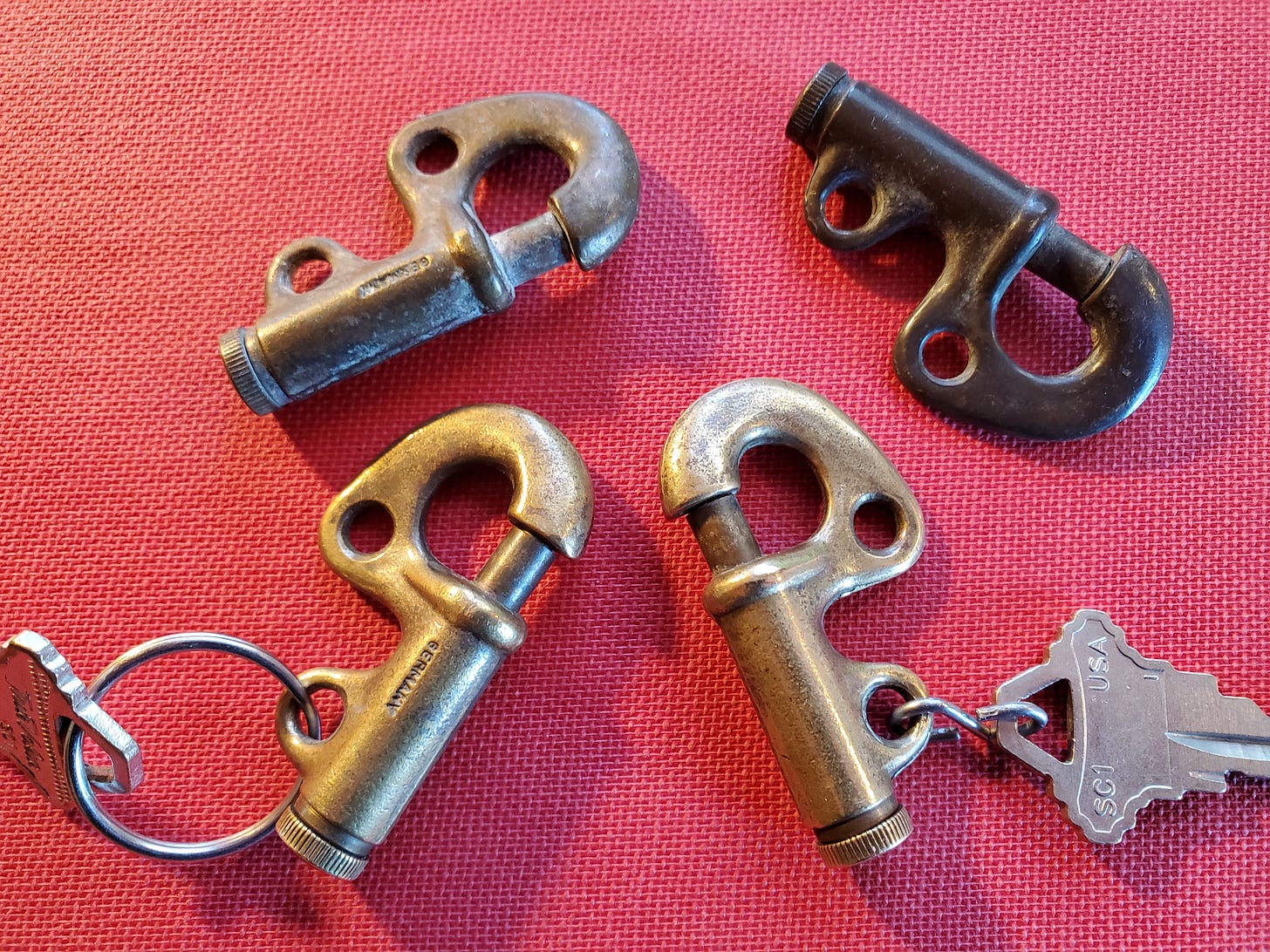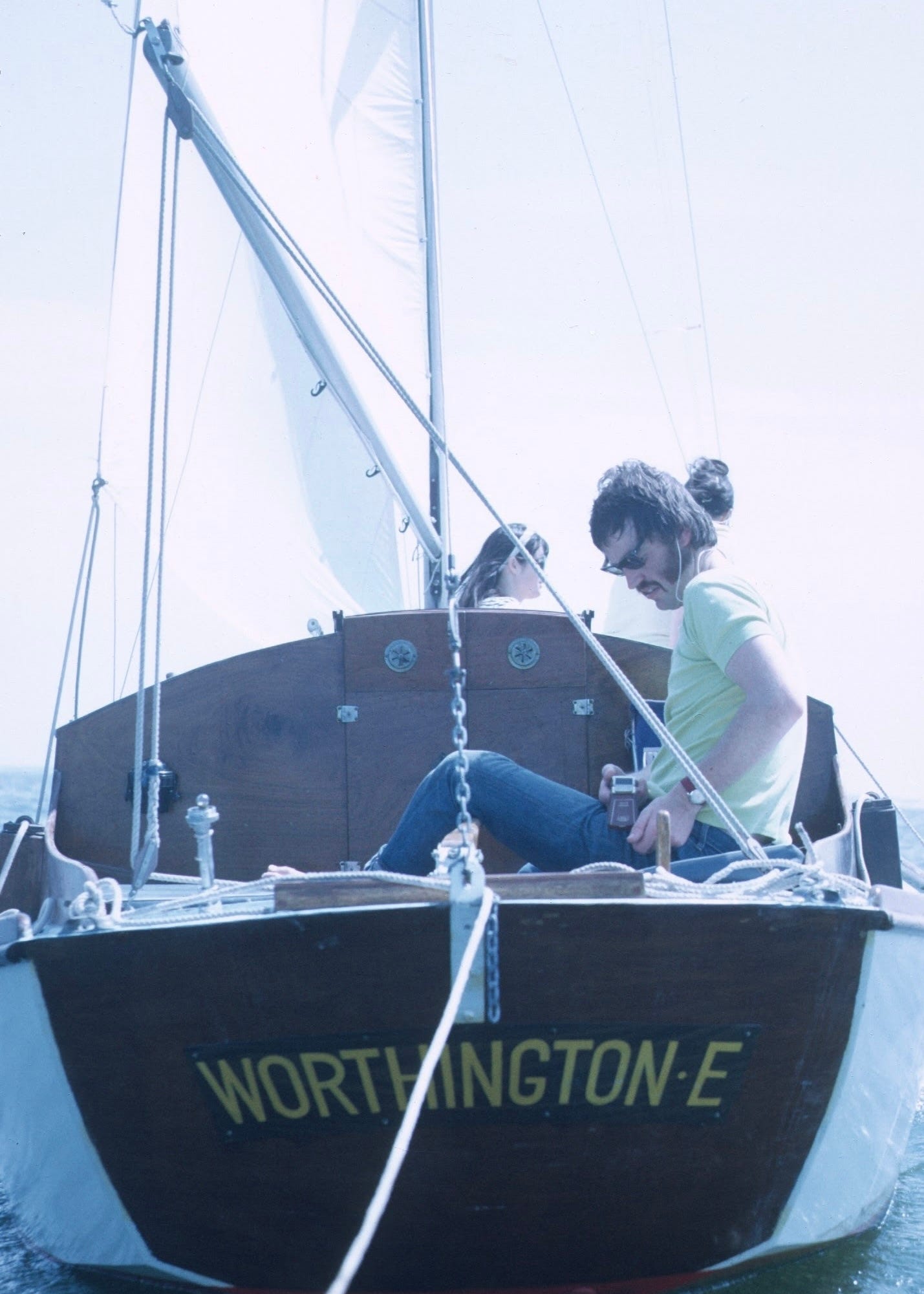This post is from the American branch of the Reason family, my brother’s son Tim, who, like my own sons, spent quite a bit of his young life being taken sailing by his father. Since this story recounts some family history, it is inevitable that I would want to correct one or two details that are not quite right. Apologies, Tim!
Throughout my childhood, if I needed a particular screw or bolt of any size – or several – I went fishing in my father’s junk drawer, a deep wooden drawer filled with fasteners and hardware of every conceivable type. Sifting bare handed through the stew of heavy metal without getting your fingers punctured or sliced was a technique all its own, especially if you were searching for the smaller screws or nuts that all inevitably drifted to the bottom.
Floating occasionally to the surface as you forcefully but cautiously stirred this astonishing variety of metal bits and pieces were these small, heavy brass clips with a little spring-loaded piston. These are jib hanks, designed to attach a jib sail to the forestay of a boat – in this case, my father’s ill-fated sailboat, the Worthington E. II.[i]
The German-made hanks, I can only surmise, were extras, since the Worthington E. II (and its predecessor, the Worthington E. I) both sank under circumstances that my reserved English father uncharacteristically admitted he found too emotionally difficult to discuss.
The Worthington E. II had already sunk once. My father bought the hull as a salvage and restored it, courting my mother by – and this seems much more characteristic – pressing her into service helping him paint the repaired hull. He wrote with undisguised glee about announcing his pending engagement to the boatyard master in a freelance article for a long-lost sailing magazine called, if memory serves, Sail, or something equally prosaic. I haven’t seen the article in 40-plus years, but the lead sentence still sticks in my head (like him, I became a writer and editor): “Hey Bill, remember that girl who’s been helping me paint my boat? Well, I’m going to marry her.”
Bill (I think that was the name) ran the 79th Street Boat Basin, a marina on the Upper West Side of Manhattan. Such a location sounds unbelievably swank today, but in the paradox that was New York City in the early 1970s, it was essentially a floating trailer park housing an improbable mix of the famous – Frank Sinatra, Godfather author Mario Puzo, former McCarthy-era and future Donald Trump lawyer Roy Cohn – and a rabble of near-indigents, including my freelance writer father, his new bride, and me, who spent the first summer of my infancy living one step above homelessness on his 23-foot sailboat. This was so my unemployed parents, both freelancing for a living article by article, could sublet their rent-controlled apartment in Chelsea (also, at the time, a relatively squalid neighborhood, not the home of Tesla dealerships and art galleries that it is now).
Saying today that you once summered on a yacht moored up in a Manhattan marina isn’t a convincing way of conveying that you spent your early childhood in straitened circumstances, but it truly was a different time.
I, of course, have no memory of this, but there are photos of me being bathed in the boat’s sink and strapped into a baby backpack that my father screwed to bulkhead next to the hatch to keep me from falling overboard. (Had the Worthington E. herself capsized, I would not have stood much of a chance).
Apparently, my parents passed a rather happy summer sailing up the Hudson River or out into Long Island Sound. A favorite story of my father’s was how perfectly cozy and fast asleep they were tied up to someone’s dock in Long Island during a hurricane … until a well-meaning resident knocked loudly on the cabin porthole to make sure they were OK because the power had gone out. (The Worthington E. II, like most sailboats even today, was not reliant on – nor in our case even connected to – the grid).
My Uncle Peter, the regular author of this blog and a skilled sailor who in his lifetime has circumnavigated the British Isles[ii] and sailed from them to Spain, Ireland, and France, still describes cowering in fear in the cockpit as his older brother insouciantly and probably recklessly navigated the tiny Worthington E. II across the path of the massive cargo ships plying NewYork harbor.[iii]
At some point in my early childhood, during another storm, Bill or someone else incurred my father’s lifelong enmity by tying the Worthington E. II up to a dock in such a way that the hull cracked and she sank to the bottom of her dock lines. Any further details are lost to me – I’d never before heard before my father say something was too hard to talk about and I never asked him again.
After he died, while cleaning out his house, I poured the contents of his junk drawer into a reinforced milk crate, vaguely noticing amid my emotional exhaustion that the heavy cascade of metal contained more of these brass hanks than I’d realized. Throughout my childhood, I had always assumed it was the same two or three that kept surfacing.
Years later, I sifted through what was now my own junk drawer and for the first time in half a century, dug them all out, eventually finding six. Google Lens easily identified their provenance and origin, and I set about wondering what to do with them. They are extraordinary, strong little pieces of machinery, but defiantly fit for only one purpose. I’ve yet to find any other practical use for them except as key fobs, mostly for spare keys that I now refuse to lend to anyone lest they lose them.
Passing through airport security recently, I watched with bemusement as a new, AI-powered x-ray machine zoomed in on the unfamiliar looking hunk of metal in the outer pocket of my backpack and then blew it up to full screen. At 10 times its actual size, it looked understandably alarming to the TSA technician and his supervisor. It seemed less so – to me, anyway – once they dug it out of my bag, my house key dangling from it, but I suppose that among the thousands of potentially dangerous items they see each day, this was unique. They spent a long time pulling back the snap piston and turning it over in their hands until finally letting me go, clearly uneasy that they didn’t know quite what to make of it.
I suppose I know a bit how they felt.
[i] Worthington E was a Silhouette, a ‘pocket cruiser’ originally made available as a kit for amateur construction from marine ply. My brother called his boat Worthington E after the beer he drank with his fellow engineering apprentices in Birmingham. I tried in vain to explain to him that in these days of ‘real ale’, filtered, pressurized beers really were passé, but he took no notice. PR
[ii] Well, not actually all the way round! PR
[iii] This may be how my big brother described it, but we were both pretty scared. Crossing the entrance to New York Harbour in a small underpowered boat is like walking across a busy motorway. PR






Thank you, Tim (and Peter) for this lovely and loving remembrance of a family, a wooden boat, and a lost time and place. In a cubby under the settee of my Newport 30, there’s an old Rubbermaid box stuffed full of the kind of hardware that Tim found in his father’s junk drawer, a wide variety of screws, bolts, and assorted sailing hardware including more than a few jib hanks. They’re unnecessary on a boat with a furling jib, but the fact that Alpha Wave’s previous owners held onto them hints at the esteem and regard they felt for them. Of my boat’s several previous owners, I only met the one who sold her to me. But I must confess to some brotherhood with them, some almost familial connection, when I’m sanding rails or coming about … or sifting through that tub of heavy, slightly oily hardware. -DWS
I loved this. The writing itself is a boat, carrying in its hold the enduring and priceless family ties.